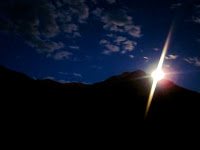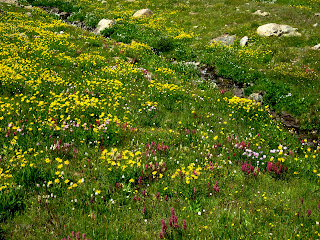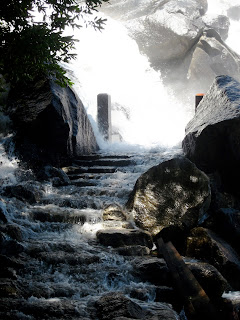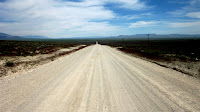Day Four, Monday June 20th: Half Dome
Standing on the summit of Half Dome subsequent to an unconventional climb felt remarkably absurd. In true Kat & Justin style, nothing about our experience was ordinary ~ enveloped by tranquility and a sense of accomplishment unlike anything I have ever felt, being here was the best moment of my life.

We had originally planned to climb Half Dome on June 21st as a day hike if we couldn’t secure a last-minute wilderness permit for Little Yosemite Valley. What happened next turned our frustration at rude and incompetent park rangers into awe at a chain reaction of favorable incidents. Upon extensive research, I discovered that we had the option to camp anywhere we wanted as long as we were beyond the designated campground and below a certain elevation. Although I explained this via telephone to Mark, an extremely unhelpful and bad-mannered park ranger, he denied any such camping existed and continued to berate me on my apparent lack of permit etiquette. Then, a few weeks before the trip, I finally managed to speak to a ranger who not only knew about the dispersed camping situation, but understood our dilemma and fixed it by issuing a wilderness permit then and there. He even rearranged the dates and changed our previously-confirmed Rancheria Falls permit to reflect the new schedule. Consequently, we were guaranteed camping solitude as well as the opportunity of summiting Half Dome on June 20th. One potential issue remained … the cables weren’t scheduled to be put in place for the season until Wednesday June 22nd, two days later.
--- The braided steel cables are always on the mountain, it’s just a matter of whether they’re “up” or not. During the offseason, they simply lie on the rock and there are no wooden boards in place to use as footholds. When the snow situation has worked itself out, the cables are raised onto a series of metal poles at regular intervals so people can hold onto them at waist-level on both sides. Some claim that, when the cables are down, the Half Dome ascent becomes the province of climbers rather than hikers; this is entirely true. ---
Just like the snowplows on Going-to-the-Sun Road and Tioga Pass, we continuously checked the status of the cables. Once we found out that they would not be in place for the day of our hike, we packed climbing gear and hoped for the best. This then explains my ominous thoughts the evening prior; photos of Half Dome without cables look downright petrifying. Moreover, the views from Olmstead Point and the Valley had made the climb appear nearly impossible. Even as we hiked the last few steps of the steep sub-dome and stood in plain sight of the dome itself, I said “There’s just no way” out loud, over and over.

I maintained this mindset even as we watched a few (literally, a few - it may as well have been deserted up there) people go up and come back down again. Though I love to climb mountains, I truly am wary of routes that combine height with significant exposure. After 30 minutes of analyzing, mentally preparing, and continuing to utter unsure statements (“You can go, and I’ll just wait right here on this rock for you”) something in me snapped. I fastened my harness, put my gloves on, and told Justin that we’d better go before I changed my mind.
A mere 400 vertical feet separated us from the summit of Half Dome ... it should take the average person about 15 minutes when the cables are in place and the crowd factor is a non-issue. For us, this section of the climb was quite labor-intensive requiring a strong grip and, primarily, upper body strength to pick the steel cables up and haul ourselves along while pausing every so often to clip in and out or switch cables altogether. Of course, I was shaking throughout the ascent … but I actually enjoyed myself! Climbing involves strategy and precision, both of which require attention and focus (making it more difficult to think about or look at how far down we could potentially fall). I did have a minor freak-out moment halfway up when I couldn’t find anywhere to put my feet while un-clipping and was saved, as always, by Justin’s calm attitude. Words fail me as I attempt to relay my feelings on the summit or describe the stunning views of Yosemite and its granite landscape from the best possible perspective in the park.



Each person we chatted with either on the summit or en route told us that going down was easier than going up. Not at all! I hated every second of the descent, and my lower back was painfully sore from tenseness for the next few days. The problem with going down is that you have to look where you’re going … down. It also took a while to figure out the best method (cable between your legs vs. cable off to the side). Justin had no trouble, as usual. Upon returning to the safety of the sub-dome, I almost started crying out of joy. We each opened a beer and toasted to a most unforgettable experience while gazing at the route we’d just taken up and back again; it still looked insane to me, maybe even more so.

The hike back to our campsite and the car was uneventful. We decided to take the John Muir Trail to avoid an inevitable soaking on the Mist Trail and to spare our knees unnecessary strain on those killer steps. On the way, we were rewarded with perfect views of our recent conquest as well as Nevada and Vernal Falls pouring into the Merced River below. We even met a man who could have been a modern John Muir himself: older, passionate about the wildness of Yosemite, and slightly crazed. I could imagine him speaking Muir’s words as if they were his own: ‘Climb the mountains and get their good tidings. Nature’s peace will flow into you as sunshine flows into trees. The winds will blow their own freshness into you, and the storms their energy, while cares will drop off like autumn leaves’.
 |
| Half Dome (left) & Nevada Falls from the John Muir Trail |
And so concludes one of the most memorable days . . .
PS: This is what the route looks like on a typical summer day when the cables are in place (the NPS does issue up to 400 permits per day). Thank God we were able to climb it under MUCH better circumstances!
-Details-
Distance: approximately 16 miles round-trip from the Valley (and quite steep)
Elevation Gain: 4,800 feet
Summit Elevation: 8,842 feet
Time: 10-12 hours on average . . . I really can't be sure how 'long' it took us
Insanity Factor: 10 out of 10, easily (the way we did it)
Hazardous/Fatal? Mmmhmm!
Worth it? Totally


























































